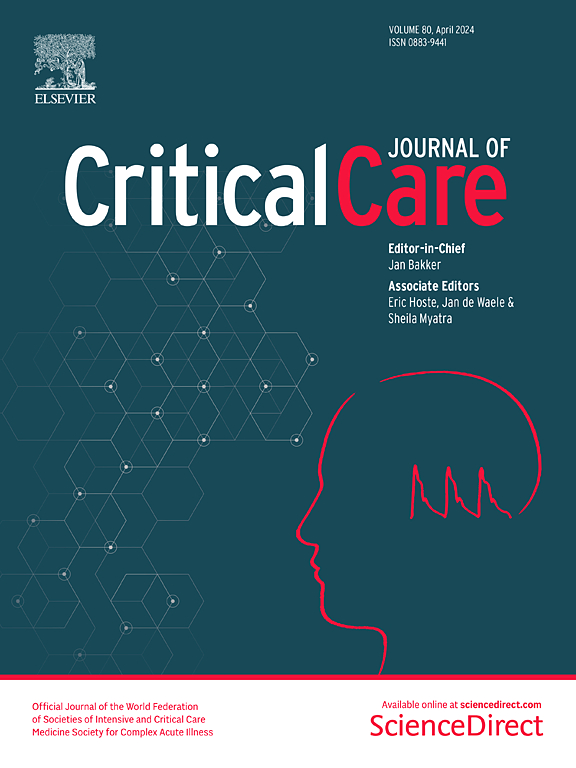Inhaled antibiotics for treating pneumonia in invasively ventilated patients in intensive care unit: a meta-analysis of randomized clinical trials with trial sequential analysis
IF 8.8
1区 医学
Q1 CRITICAL CARE MEDICINE
引用次数: 0
Abstract
The use of inhaled antibiotics for treating pneumonia in invasively ventilated patients offers a direct approach, allowing for high local concentrations of the drug in the lower respiratory tract while simultaneously reducing systemic toxicity. However, the real efficacy and safety of nebulized antibiotics remain unclear. The aim of the present is to assess among critically adult patients with pneumonia and invasive ventilation, whether receiving adjuvant inhaled antibiotics improves the rate of microbiological eradication. A comprehensive literature search of randomized clinical trials (RCTs) was conducted (from inception until September 20, 2024, PROSPERO-CRD592906) across Medline, Embase, and Scopus. Randomized controlled trials, enrolling intensive care units (ICU) patients with pneumonia and comparing nebulized antimicrobial therapy (inhaled group) with intravenous antimicrobial treatment or intravenous antimicrobial therapy plus inhaled placebo (control group), were included. The primary outcome was the rate of microbiological eradication after treatment. Secondary outcomes were the rate of clinical recovery, the incidence of drug-related adverse events, ICU and hospital mortality. A qualitative analysis was conducted according to the GRADE framework. Data were pooled using an odds-ratio analysis. The heterogeneity and reliability of our results were evaluated using the I2-statistic and trial sequential analysis (TSA), respectively. A total of 11 RCTs (1472 patients) met the inclusion criteria. Compared to controls, the use of adjuvant inhaled antibiotics determined a greater rate of microbiological eradication (OR 2.63, 95% CI 1.36–5.09; low certainty of evidence). The TSA confirmed the reliability of our primary outcome. Moreover, nebulized antibiotics increased the risk of bronchospasm (OR 3.15, 95% CI 1.33–7.47; high evidence), while nephrotoxicity, clinical recovery, ICU and hospital survival (either in the case of pneumonia caused by MDR bacteria or not) were not different between groups. In conclusion, compared to the sole intravenous therapy, the use of adjuvant inhaled antibiotics for treatment of pneumonia in invasively ventilated critically ill patients was associated with a greater incidence of microbiological eradication (low GRADE and high risk of publication bias), but not with clinical recovery and survival.吸入抗生素治疗重症监护室有创通气患者的肺炎:随机临床试验的荟萃分析与试验序列分析
使用吸入式抗生素治疗侵入性通气患者的肺炎是一种直接的方法,可使药物在下呼吸道局部高度集中,同时降低全身毒性。然而,雾化吸入抗生素的实际疗效和安全性仍不明确。本研究旨在评估成年重症肺炎患者接受有创通气治疗后,辅助吸入抗生素是否能提高微生物根除率。我们在 Medline、Embase 和 Scopus 上对随机临床试验(RCT)进行了全面的文献检索(从开始到 2024 年 9 月 20 日,PROSPERO-CRD592906)。纳入的随机对照试验招募了重症监护病房(ICU)的肺炎患者,并比较了雾化抗菌治疗(吸入组)与静脉注射抗菌治疗或静脉注射抗菌治疗加吸入安慰剂(对照组)。主要结果是治疗后微生物根除率。次要结果为临床康复率、药物相关不良事件发生率、重症监护室和医院死亡率。根据 GRADE 框架进行了定性分析。采用几率分析法对数据进行了汇总。我们分别使用 I2 统计量和试验序列分析(TSA)对结果的异质性和可靠性进行了评估。共有 11 项 RCT(1472 名患者)符合纳入标准。与对照组相比,使用辅助吸入抗生素可提高微生物根除率(OR 2.63,95% CI 1.36-5.09;证据确定性低)。TSA证实了我们主要结果的可靠性。此外,雾化吸入抗生素会增加支气管痉挛的风险(OR 3.15,95% CI 1.33-7.47;高证据),而肾毒性、临床恢复、ICU 和住院生存率(无论是否由 MDR 细菌引起的肺炎)在各组之间没有差异。总之,与单纯静脉治疗相比,使用辅助吸入抗生素治疗有创通气重症患者的肺炎与更高的微生物根除率相关(低GRADE,高发表偏倚风险),但与临床康复和存活率无关。
本文章由计算机程序翻译,如有差异,请以英文原文为准。
求助全文
约1分钟内获得全文
求助全文
来源期刊

Critical Care
医学-危重病医学
CiteScore
20.60
自引率
3.30%
发文量
348
审稿时长
1.5 months
期刊介绍:
Critical Care is an esteemed international medical journal that undergoes a rigorous peer-review process to maintain its high quality standards. Its primary objective is to enhance the healthcare services offered to critically ill patients. To achieve this, the journal focuses on gathering, exchanging, disseminating, and endorsing evidence-based information that is highly relevant to intensivists. By doing so, Critical Care seeks to provide a thorough and inclusive examination of the intensive care field.
 求助内容:
求助内容: 应助结果提醒方式:
应助结果提醒方式:


